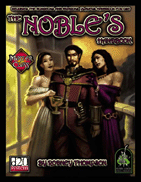
|
About OgreCave and its staff
|

|
by Justin Mohareb
Aristocrats are a popular choice for Player Characters. Everyone wants to play a character of noble birth, so it might be interesting to see why they are so popular, especially since most players come from countries that have rejected the traditional concepts of aristocracy. I mean, a ruling class composed of tightly knit families who pass the reigns of power from one generation to the next, with possible interruptions by usurpers? Privileged sons who take underhanded actions to avenge slights to their fathers? Preposterous, especially in this day and age.
Who would be king? The Noble class is a Charisma based class. Focused on being bred to the bone as leaders of men, when a noble says, "listen," he expects his co-adventurers to listen. They'll be better off for listening, since a Noble can inspire his comrades (a class ability starting at level 2, similar to the Bard's ability), and at higher levels he can organize them (which allows him to coordinate his teammates' use of the Aid Another action). At sixth level, the Noble receives the Leadership feat for free, giving him both followers and a cohort. The class is based around being a leader of men/women/hobbits, and as such needs followers. At first level, a Noble character receives a Breeding special ability and the Noble House feat for free. Breeding gives the Noble a choice of abilities that in effect allow him to function as a watered down version of some of the other classes. Breeding abilities include a bonus to one Knowledge skill, the ability to cast a 0-level arcane spell once per day, a bonus Exotic Weapon proficiency, or bonus to Diplomacy and a bonus language. It may also be a bonus to Diplomacy OR a bonus language, but layout issues on that page muddy the issue. The free Noble House feat makes the character the leader of a Noble House. This gives them no special abilities, lands, or even a title. The House has a rating of 1, which will increase as the Noble's levels go up. As the House's rating goes up, a Noble will gain titles, lands and houses, as well as enemies. His House also gains its own special bonuses, such as a feat or a skill bonus shared by all the members of the House. The prestige classes included in the book can be used by character types other than nobles, but all of them except one require the Leadership feat, even if it doesn't seem entirely logical. Why, for example, would the Master Diplomat require the Leadership feat? Wouldn't a skill feat that provides +2 to Diplomacy and Sense Motive be more appropriate? New uses for Skills and new Feats are also included, as well as a dueling system, which is built around a new set of maneuvers. Though interesting, the system could have used some more explanation of how to integrate it with standard d20 combat. A few of the new feats seem tailored to the dueling system which replaces the standard rules, perhaps unnecessarily, instead of supplementing them After a chapter of magical items, we get to the chapter on playing noble characters. Unfortunately, it's one of the weakest of the book. There are a few bits on various noble personalities as well as a short section on the noble in various game environments (city, dungeon, and wilderness) and Events for Nobles (big balls that should be held every night, tournaments and court). The rest of the chapter discusses noble archetypes, primarily multiclass combinations of Nobles and other classes. These are certainly interesting ways to use the Noble class, and would help a player plan his character's advancement.
I am sorry to report, my lord... The section on Noble Houses also ends up being less than it should be. The rules are based around increasing the house's rating by attaching it to player advancement. A passing mention is made that a DM can increase a rating by a point or two if the Player Character impresses people or gains a group of followers. Which is good, sure. But what if the Noble gets a sudden promotion? What if the king decides to grant a Player Character Noble the title of Duke? Or if Lady Player Character gets married to a Duke? What if the character applies a certain amount of money to raising his status within the kingdom (since adventurers have a habit of stumbling on caches of jewels and riches), or finds a new trade route to a far-off nation? How do you handle a house that has two Player Character Nobles associated with it None of those questions are answered. A few more paragraphs of information about running a noble house could help, especially if a DM has players who are in favor of aggressively improving their house's fortune. A few more pages would definitely have been appropriate, considering a Noble's house is as important to him as a Wizard's spells or a Fighter's feats. Instead of more details, the book rounds out with a few sample noble houses. Visually, The Noble's Handbook is well put together, with good interior work and a good cover. The only question I have about the cover is why Minnie Driver seems to have been cast as the maiden on the right. Layout and design, like all Green Ronin books, is tight, although one page has two fairly egregious errors -- an unfilled page reference and one paragraph that could have been two.
Conclusions
|
||
 The Noble's Handbook
The Noble's Handbook